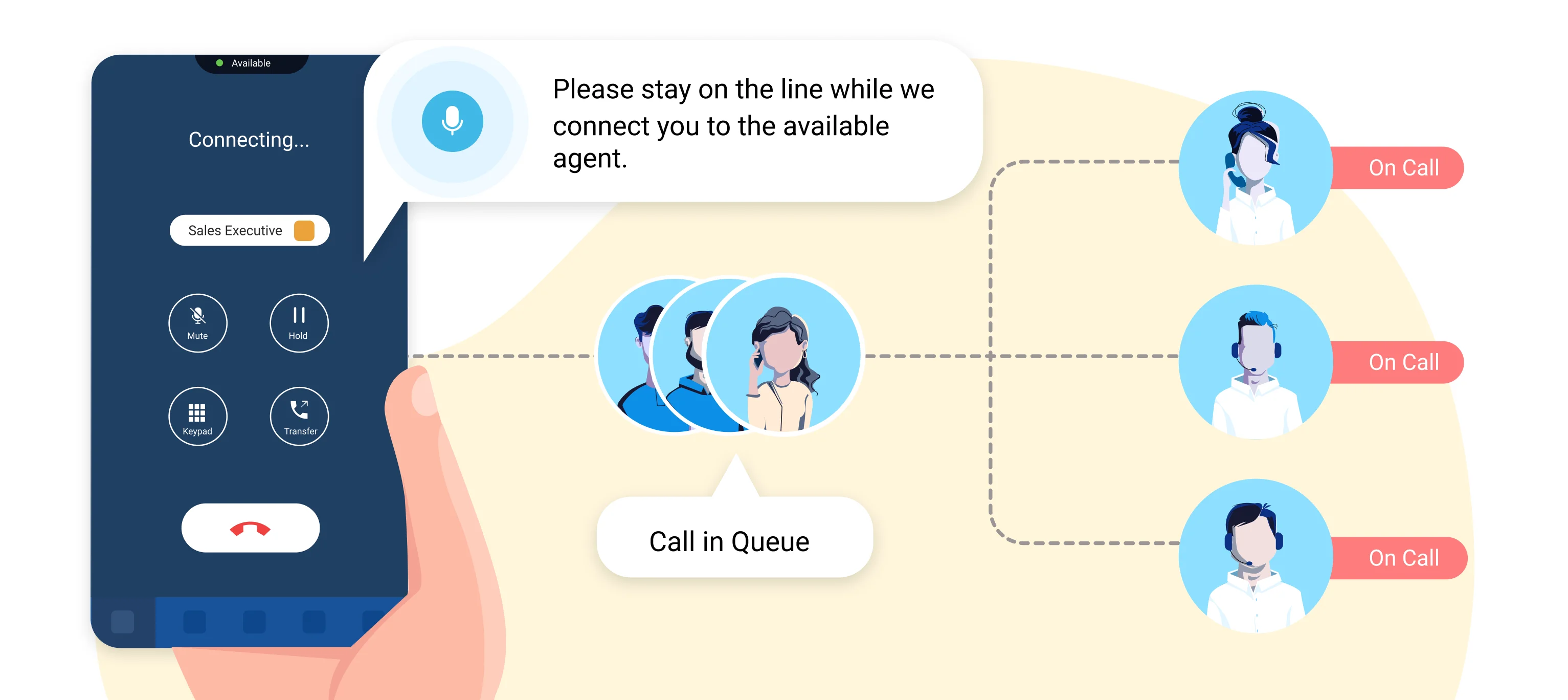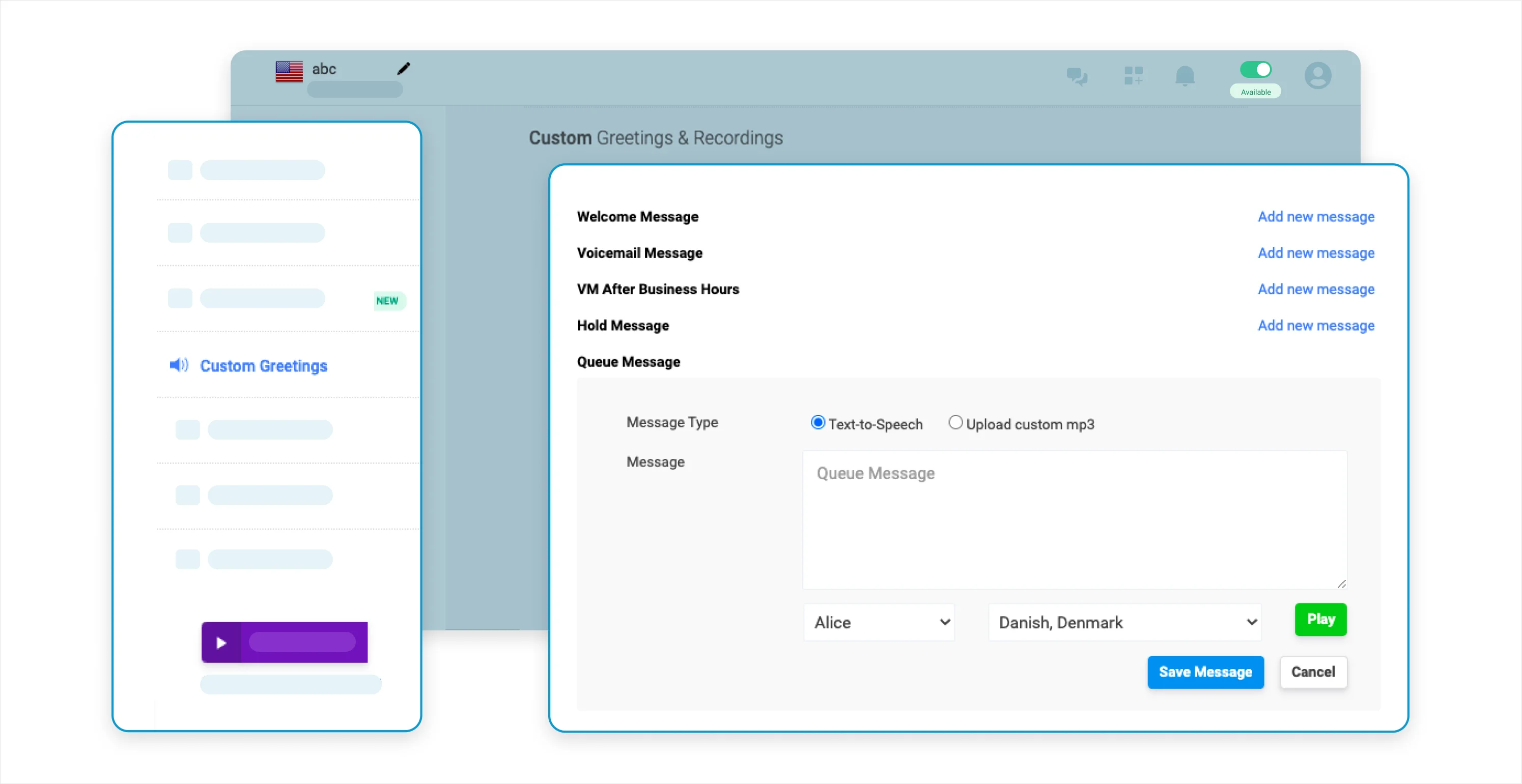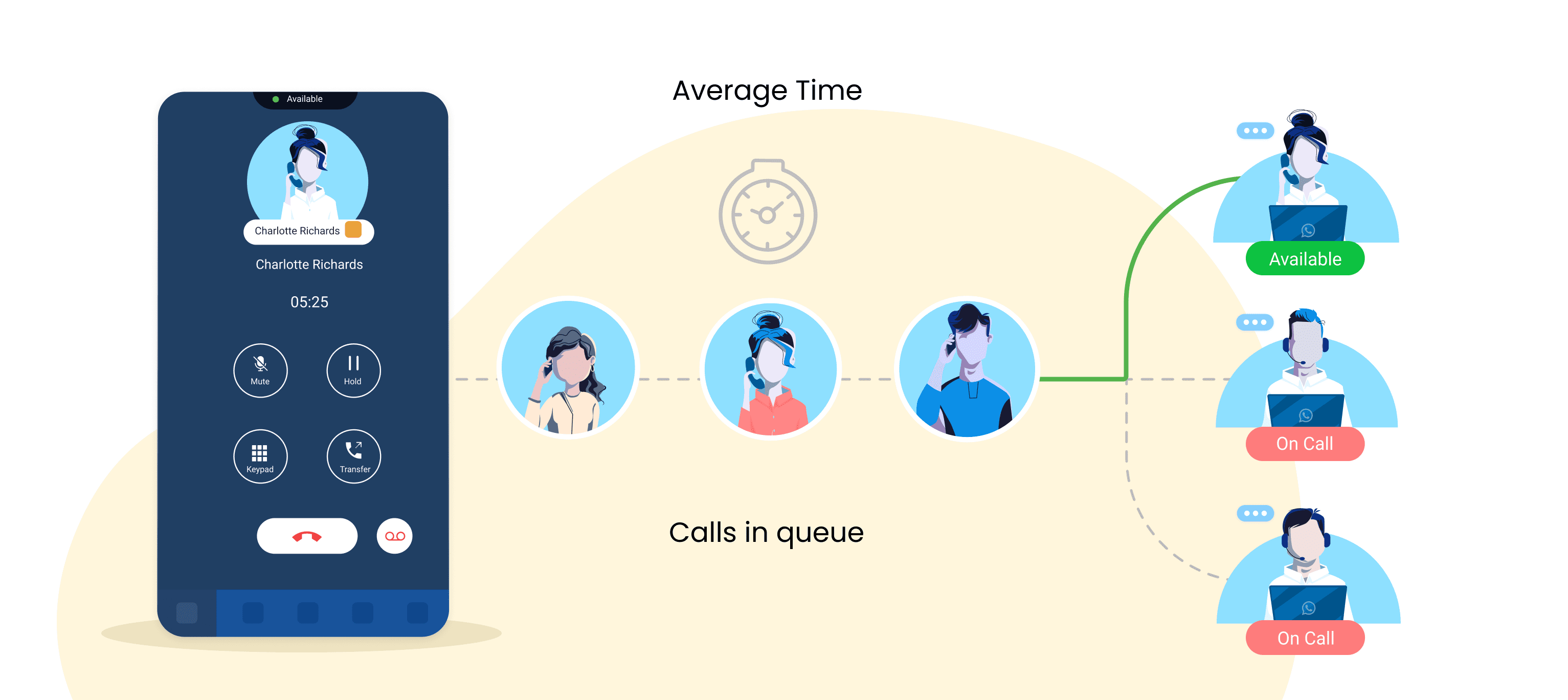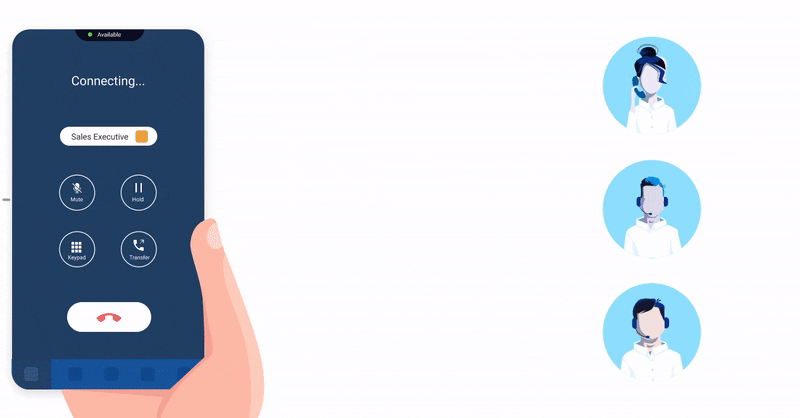Did you know that more than 58% of customers believe that waiting on hold for 1 minute is too long? Long wait times result in many abandoned calls and customer dissatisfaction.
The average wait time for a call center or contact center customer is 20 seconds. If callers are made to wait longer, they hang up. But how do you make sure that callers wait patiently till they connect with an available agent?
Call queuing is the solution.
In this blog, you’ll learn everything about call queues- right from call queue meaning, how it works, call queue management and how it can improve call center experience.
What is a Call Queue?
Call queues are an important component of call centers and contact centers. A call queue brings uniformity to call inflow management.
The aim of call queuing is to cut down wait times and, by doing that, increase customer satisfaction. If you have an auto attendant system, it can handle inbound calls and place them in the call queue according to pre-set priorities.

Why Use Call Queuing for Call Center Business?
Contact centers that are overloaded with incoming calls also face a lot of abandoned calls. The sole reason behind this is long wait times.
Customers hang up. They may call back with a mind to make a deal, or they might never do so. So there’s a great possibility that you might’ve missed a deal.
Plus, you don’t know how many deals you (along with your teammates) have lost till now. This brings call queuing into the frame.
Call queues hold callers in wait for a definite period of time. During this waiting period, an automated voice reassures them every second that their call will soon connect to the agent as soon as they are available.
Ready To Transform Your Customer Experiences?
How do Call Centre Queues Work?
Call center queues are based on the “First In, First Out,” aka FIFO policy. Call centers use an Automatic Call Distributor (ACD) to distribute incoming calls to specific resources (agents) in the center.
ACDs hold queued calls until agents become available.
Imagine you have a call center of 10 agents. A time comes when all your callers are busy on calls attending to clients. But incoming calls don’t stop.
So, what happens? Are you going to make all the callers go away by giving them the busy tone? No.
As a common practice, callers press the IVR inputs one by one. Their IVR response takes them to their required department, suppose here, sales agent Alex.
Alex is busy on a call. But there are callers who want to specifically talk to Alex, and such callers keep adding up.
What happens now? Call queuing comes into action. All these callers get aligned in their sequence of incoming calls in a queue.
Alex gets the ringing notification. He knows there are callers in the queue for him to attend.
While in the queue, the callers hear a welcoming voice note along with an automated voice that keeps them informed about how soon they will be able to connect with their agent of choice.
When Alex puts down the phone, caller number 1 in the queue gets connected with Alex within the next fraction of a second.
Then the call queuing goes on. This happens with all agents across all departments in a call center or contact center.
5 Challenges of Call Queuing
The FIFO approach to call queuing works best when you have the right technology and the appropriate number of staff, or else you might run into some of the challenges mentioned below:
1. Extended Wait Times
Lack of staff can lead to customers waiting in queue for a very long time. This might frustrate them, leading them to hang up the call or take out the frustration on the customer representative.
The situation is stressful for the staff and the customer and leads to a negative experience for both.
2. Outdated Technology
Outdated software impedes efficient communication, making it difficult for your customer rep to get through the queue.
If the software doesn’t integrate seamlessly with your CRM solution, it will frequently need to place the customer on hold while accessing customer information from different systems.
3. Inadequate Staffing
There are certain times during a day, week, or year when call centers see a surge in the number of calls. If managers cannot anticipate call spikes and increase their staff accordingly, they’ll again end up making your callers wait an eternity.
This will lead to the same sorry state of overwhelmed staff and frustrated customers.
4. Prioritization Issues
The ideal approach for any customer support team would be to quickly address callers with simple problems and dedicate more time and attention to customers with complicated issues.
Yet, that’s not always possible with call queuing systems that work on a first-come, first-serve basis.
5. Queue Anxiety
The uncertainty of the waiting period often tends to give callers queue anxiety. To reduce such anxiety, providers like Microsoft Teams enable their callers to see the Teams call queue agent status.
You can handle these challenges of phone call queuing with better queue management techniques, such as call routing.
How is Call Queuing Related to Automated Call Routing?
Based on IVR inputs, the ACD routes calls to the departments, and queues handle callers while the best agents become available.
What are the Call Routing Options in Call Queues?

1. Working Hours
Call centers and customer satisfaction go hand in hand. In order to live up to customers’ expectations, their queries need to be solved.
To solve queries, you need an ample number of agents to be available, which is why their hours of availability matter.
When does your business receive calls—during the week and on weekends or on holidays? The ‘working hours’ section shows it all.
2. Pre-recorded Greetings
JustCall enhances your caller’s experience with custom music or a personalized message while they wait for the next available agent.
You can also customize each queue experience by choosing to play pre-recorded messages for customers as they wait to connect. These keep them informed about relevant company information.
Pre-recorded greetings keep customers engaged while waiting in virtual queues.
Sometimes, music creates magic!
However, pre-recorded messages can be text-to-voice converted messages. You can also upload a custom audio file. This greeting message will keep the customers engaged and lower their anxiety.
3. Even Call Distribution – ACD System
An ACD system is basically a call routing system. It filters calls using preset parameters and serves two major purposes:
a. Connects customers with agents of the correct domain having the right experience and expertise
b. Gets callers answered right away, creating positive customer experiences.
4. Efficient Call Routing with Call Queuing
Under common practice, callers get routed to requisite departments based on their IVR inputs.
While agents are busy on calls, call queuing handles the waiting callers and connects them with the available agent based on FIFO policy, as stated above.
This fulfills the goal of cutting down customer wait times.
5. Advanced Call Analytics
Callers can also drop off the queue and put in the request of ‘queue call back.’
Managers can keep an eye on their agents’ performance. They can also customize specific call routing strategies based on the agent’s busy hours.
For example, incoming calls go to the least active agent. The least active agent is one with the fewest calls or the longest idle stretch between calls.
What are the Types of Routing in Call Queues?
Companies can take various approaches to call routing depending on their size, industry, and customer concerns. Here are ten different types of call routing:
1. Direct Routing
This is a very basic call routing approach. Here, calls are routed to a specific department to which the query is related. They’re often connected to one agent or, if they’re busy, to the next agent on the list.
2. Least Idle Routing
This sophisticated routing strategy directs calls to the least occupied agent or the agent waiting for a call the longest. This strategy helps in the equal division of work between agents.
3. Skill-Based Routing
This routing matches the call to the most skilled or experienced agent handling that kind of query. It leads to efficient utilization of resources and faster resolutions.
4. Dynamic and Service Level Routing
If skilled agents have more than usual wait times, dynamic routing pulls more agents to the queue to preserve the service level. This results in higher customer satisfaction.
5. Intelligent Call Routing
Intelligent routing directs calls to the best enterprise resource, be it self-service or a dedicated agent, based on their IVR interaction at the beginning of the call.
6. Business Rules Routing
This call routing strategy is set to support specific business objectives.
For instance, high-value customers are connected to premier agents. Similarly, customers on the verge of departure are connected to dedicated retention teams.
7. Data Directed Routing
Data-directed routing uses customer intelligence to direct the call to the appropriate agent based on their current status.
For instance, a credit card customer who has missed payment would first be routed to the collection department.
8. Value-Based Routing
Value-based routing redirects calls based on the customer’s known or perceived value. The value is derived based on attributes such as their previous actions or their demographics.
9. Outbound Routing
Outbound call routing is the process of routing calls from agents to customers on behalf of the call center or client. The calls are made for customer notification, telemarketing, post-sales follow-up, fundraising, etc.
10. Multimedia Routing
This is a kind of outbound routing where other communication media is converted into a call. An example is a customer receiving a call after sending an email to the contact center.
What Causes Long Call Queues?
Call queue management can be very effective at reducing waiting times. However, it’s essential first to understand what causes long queues.
Here are some of the main reasons behind long call queues:
1. Untrained Staff
If your agents aren’t trained to deal with queries that come their way, they’ll inevitably take longer to resolve them. Unfortunately, many managers overlook this primary reason for long call queues.
Training webinars, internal wikis, and free-training courses are some tools that will empower your staff members to provide quick and effective customer service.
2. Lack of Staff
Even with trained staff, there are only so many calls a single agent can handle. Having inadequate staff to go through the incoming calls will undoubtedly lead to long queues. You can deal with this problem by hiring more people or outsourcing the task.
3. Absence of Customer Self-Service
A customer self-service portal can be an effective tool for reducing the load on your agents. You can set up your IVR to answer simple call queries and make payments.
You can also set up an online knowledge database and video tutorials so customers can figure out the solution themselves. Similarly, chatbots could provide additional support.
These self-service portals will free up agents’ time to better tend to complex queries that need detailed assistance.
4. Peak Call Season
Even with enough trained staff, peak call seasons can be overwhelming. It’s crucial to identify these periods and be prepared for them.
Here again, self-service via IVR could come to the rescue. Similarly, you can equip staff with detailed scripts and knowledge, so they can help other departments if needed.
5. Unsuitable Call Center Software
With so many different software available, choosing the right one for your call center can be tricky.
Software that’s not user-friendly or lacks necessary features can slow down your team. Try to find software that suits your work style and requirement.
How to Set Up Call Queues with JustCall?
In IVR, if you’ve set up call forwarding to ring team members and all your agents are busy, you can now forward your unanswered calls to Queue until one of the agents is available to answer.
Setting up IP phone queue systems with JustCall is very simple. Follow the steps given below to reduce the number of abandoned calls:
1. Head over to the Phone number settings.
2. You can see the Unanswered section under the Incoming Call Setting section of the Phone Number page.

3. Select the Queue option from the drop-down and simply click on Save.
4. Similarly, you can also set the wait time for the callers in the queue under the Settings page.
5. To allow callers to drop off the queue, you can also toggle off/on the callback request. This allows or restricts the callers from leaving a voicemail while in the queue.

6. Users can also add a custom queue wait mp3 under the custom greeting section on the phone number page.

Why Call Queue Management is a Must-Have for Call Centers
Call queue management is an overall system to ensure that the customer wait time is minimal. It also ensures fair workload distribution to the agents working.
When done correctly, good call queue management reduces wait times and leads to an overall better customer experience in call centers and contact centers.
Let’s see how.
1. Reduce Call Abandonment Rates
Call queue management employs an effective call queuing system that reduces wait times. The first to wait in a queue is the first to get on a call with the available agent.
Callers can also request a queue callback if they don’t wish to wait on calls. JustCall call center teams will call them back as soon as agents are available.
This increases customer satisfaction rates and reduces call abandonment rates.
2. Increase First Call Resolution (FCR) Rates
Companies that achieve 5-star customer satisfaction have an average FCR rating of 86%.
First call resolution (FCR) emphasizes resolving customer service issues and meeting customer needs when customers call a business the first time without making them follow up with a second call.
By routing to the right agent straight away, you also increase the chances of a customer’s issue being fixed on the first call, greatly improving their satisfaction with your service.
Let Call Queues Do Their Work
By now, you must be well aware of how call queues handle the incoming tide of calls during peak times in call centers and contact centers.
While the ACD system routes the calls to the chosen departments, call queues make sure that the caller gets connected with the right expertise as soon as they are available.
Are you still in doubt regarding any of the above-discussed features or want to know more about how call queuing will fit into your business goals?
Our experts are just a call away!













